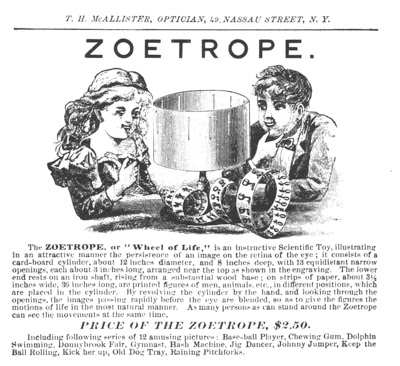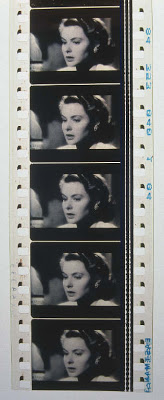Philosophy



 It is strange how the brain can perceive a series of still images and translate them into motion. It is called "the persistence of vision" and explained by Michael McKinney:
It is strange how the brain can perceive a series of still images and translate them into motion. It is called "the persistence of vision" and explained by Michael McKinney:
Finally, make a zoetrope yourself:
George Eggers Page
- Sex And The Homunculus Problem Of Mind
When it comes to theories of mind, cognition and perception, there are a number of tools philosophers use in order to separate potentially workable theories from hypotheses that just don't have what it takes to even get off the ground. One of these...
- Mona Lisa's Smile
Leonardo's Mona Lisa's smile is being scrutinized by scientists and claiming that the "smile" significance is a function of the human eye. "The secret behind Mona Lisa's enigmatic smile" The secret behind Mona Lisa's enigmatic smile...
- Zoetrope Anniversary
In 1867, the Zoetrope was patented by William E. Lincoln of Providence, R.I. (No. 64,117). The device was the first animated picture machine. It provided an animation sequence of pictures lining the inside wall of a shallow cylinder, with vertical slits...
- 3d
Here Are A Few Anaglyph Images. They Do Require Those Special Red/Blue Glasses. Here Are A Few Internet Sources. They Can Be Purchased At Hobby And Toy Stores Too. 3D ANAGLYPH GLASSES STUDIO 3D The 3D Market And... Spencer Sundell's 3D Movie Page...
- False Astronomy Colors And Epistemology?
This in essence is a question of epistemology and the truth of the knowledge of what is presented to us via terrestrial and "in space" instruments that provide us photographs of objects beyond Earth. I vacillate between the Spitzer and Hubble images for...
Philosophy
Persistence of vision



Our eyes are one of the five specialized ways our mind uses to form a picture of world. The eye is a remarkable instrument that has certain characteristics that help us to process the light we see in such a way that our minds can create meaning from it.
The motion picture, the scanning of an image for television, and the sequential reproduction of the flickering visual images they produce, work in part, because of an optical phenomena called the persistence of vision and its psychological partner, the phi phenomenon—the mental bridge that the mind forms to conceptually complete the gaps between the frames or pictures. Persistence of vision also plays a role in keeping the world from going pitch black every time we blink our eyes.
Whenever light strikes the retina, the brain retains the impression of that light for about a tenth of a second—depending on the brightness of the image—after the source of that light is removed from the eye. This is due to a prolonged chemical reaction. As a result, the eye cannot clearly distinguish fast changes in light that occur faster than this retention period. The changes either go unnoticed or they appear to be one continuous picture to the human observer. This fundamental fact of the way we see has been used to our advantage.
When we go to the movies, we know that a motion picture creates an illusion of a constantly lit screen by flashing separate, individual photographs in rapid succession. Even though the movie screen appears to be constantly lit, it is in fact dark about half the time. This flickering image on the screen gave rise to the old term “flicks” in the early days of movies. Today’s motion pictures flash a picture on the screen at flicker-free 24 frames per second.
The motion picture, the scanning of an image for television, and the sequential reproduction of the flickering visual images they produce, work in part, because of an optical phenomena called the persistence of vision and its psychological partner, the phi phenomenon—the mental bridge that the mind forms to conceptually complete the gaps between the frames or pictures. Persistence of vision also plays a role in keeping the world from going pitch black every time we blink our eyes.
Whenever light strikes the retina, the brain retains the impression of that light for about a tenth of a second—depending on the brightness of the image—after the source of that light is removed from the eye. This is due to a prolonged chemical reaction. As a result, the eye cannot clearly distinguish fast changes in light that occur faster than this retention period. The changes either go unnoticed or they appear to be one continuous picture to the human observer. This fundamental fact of the way we see has been used to our advantage.
When we go to the movies, we know that a motion picture creates an illusion of a constantly lit screen by flashing separate, individual photographs in rapid succession. Even though the movie screen appears to be constantly lit, it is in fact dark about half the time. This flickering image on the screen gave rise to the old term “flicks” in the early days of movies. Today’s motion pictures flash a picture on the screen at flicker-free 24 frames per second.
How You See It
1936
1936
Finally, make a zoetrope yourself:
George Eggers Page
Ruth Hayes Page
BBC
EASTMAN HOUSE
- Sex And The Homunculus Problem Of Mind
When it comes to theories of mind, cognition and perception, there are a number of tools philosophers use in order to separate potentially workable theories from hypotheses that just don't have what it takes to even get off the ground. One of these...
- Mona Lisa's Smile
Leonardo's Mona Lisa's smile is being scrutinized by scientists and claiming that the "smile" significance is a function of the human eye. "The secret behind Mona Lisa's enigmatic smile" The secret behind Mona Lisa's enigmatic smile...
- Zoetrope Anniversary
In 1867, the Zoetrope was patented by William E. Lincoln of Providence, R.I. (No. 64,117). The device was the first animated picture machine. It provided an animation sequence of pictures lining the inside wall of a shallow cylinder, with vertical slits...
- 3d
Here Are A Few Anaglyph Images. They Do Require Those Special Red/Blue Glasses. Here Are A Few Internet Sources. They Can Be Purchased At Hobby And Toy Stores Too. 3D ANAGLYPH GLASSES STUDIO 3D The 3D Market And... Spencer Sundell's 3D Movie Page...
- False Astronomy Colors And Epistemology?
This in essence is a question of epistemology and the truth of the knowledge of what is presented to us via terrestrial and "in space" instruments that provide us photographs of objects beyond Earth. I vacillate between the Spitzer and Hubble images for...
